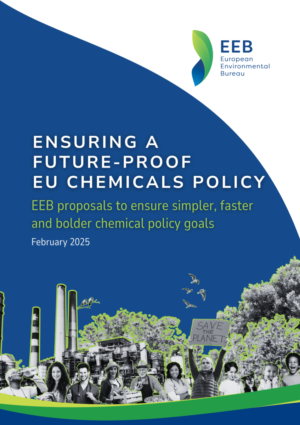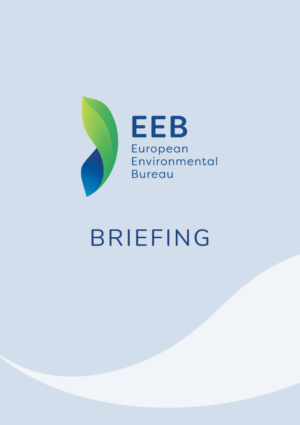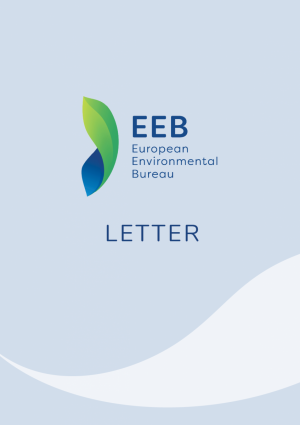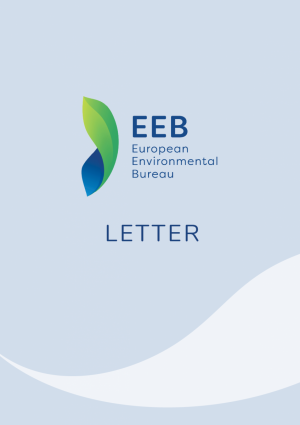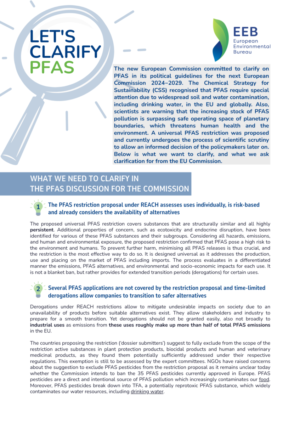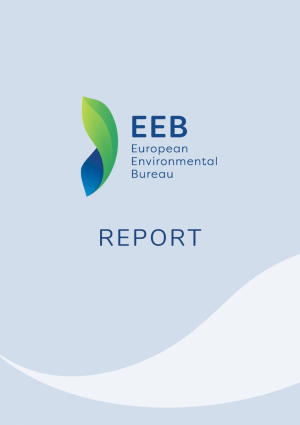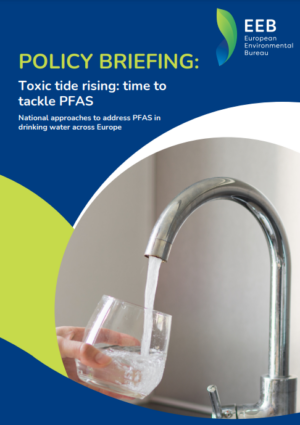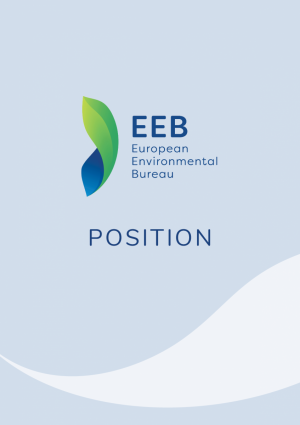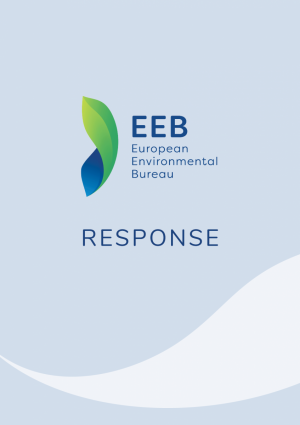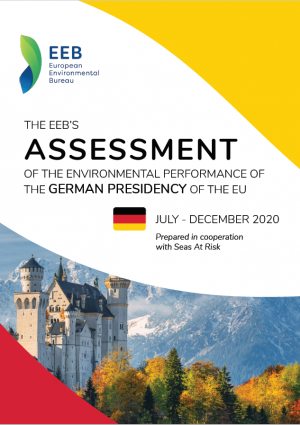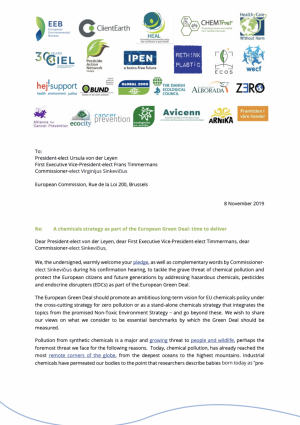What are PFAS?
Per-and polyfluoroalkyl substances (PFAS) are a family of more than 10,000 chemicals that can be found in a wide range of products, in the environment and in our bodies.
PFAS are man-made substances created by replacing hydrogen atoms (the natural bonding partner for carbon) with fluorine atoms. This gives PFAS water and oil repellent properties. These properties are sought after in many industrial production processes but come at a cost: the fluorinated parts of emitted PFAS are not degradable. This means that once released into the environment, these PFAS cannot be broken down into carbon dioxide or methane by bacteria, enzymes, or sunlight, earning them the name of ‘forever chemicals’.
‘Default’ hydrocarbon and partially fluorinated counterpart: octan-1-ol (left) and 6:2 fluorotelomer alcohol (middle), which degrades into PFHxA (right) and into other persistent substances.

Why are PFAS an issue
Thousands of PFAS have been identified, and hundreds are produced industrially. Around 100,000 sites in Europe are estimated to emit PFAS into the environment. Adding complexity to the issue of PFAS contamination, not all PFAS are equal. The non-fluorinated parts of emitted PFAS do in fact degrade.
The PFAS found in the environment are therefore not necessarily identical to the ones that companies produce; from the moment they are emitted to the moment they are found in the environment, these PFAS may undergo changes that effectively make them ‘new PFAS’, distinct from their original form. This makes it more challenging for regulators to properly regulate them.
While some PFAS bioaccumulate, building up in ecosystems - including in humans - other PFAS are very mobile and easily travel to any part of the globe. They have the ability to dissolve in water (but not disappear). Yet others can be volatile and become airborne. Therefore, they easily transit to other parts of the ecosystem through water and air
PFAS Sources
Everyday we come into contact with these ‘forever chemicals’ as they’re found in a variety of products, from food packaging to frying pans and raincoats. Not surprisingly, people all across Europe already have high levels of these dangerous chemicals in their bodies.
The main route how humans take up PFAS in their bodies is through food and drinking water. PFAS got into our soil and water bodies that serve as drinking water sources through several ways. Main point sources include industrial pollution from PFAS production and use sites, sites where PFAS were applied through fire-fighting foams that contain them, but also through PFAS containing pesticides.

PFAS Pollution issues in Europe

Pollution
The “Forever Pollution Map” showing the identified and presumptive contamination sites in Europe was developed in an outstanding collaboration project of journalists across Europe. It is highly alarming see how advanced the PFAS pollution is and how exposed EU citizens are.
More details and insights from local pollution hotspots and how affected the communities are, the Health and Environment Alliance (HEAL) collected on this website.


Human Health Exposure
PFAS are linked to a number of serious health problems, including cancer, infertility, birth defects and immune system disorders.
Harmful substances do not discriminate. Everybody can be exposed, no one is immune to chemical pollution, regardless how or where they live.
However, the people most at risk of adverse health effects are those exposed to high levels of PFAS and vulnerable population groups, such as children and the elderly.
In this video you will find some tips to reduce exposure to PFAS.


Water Pollution
Humans are exposed to PFAS via different pathways, but food and drinking water represent the main one. Spreading through water, ‘Forever chemicals’ not only threaten drinking water supplies, but also bioaccumulate posing a serious danger to wildlife and human health.
Once entering the water cycle, PFAS cannot simply be removed from water by using established drinking water treatment methods. Applicable methods are still under development yet it is already clear – society will face immense treatment cost, borne by the public.
While limiting PFAS in natural waters (surface and groundwater) decreases the need for treatment to provide drinking water, it also limits the exposure of wildlife to PFAS and benefit biodiversity.
To go more deeply into this: Toxic tide rising: time to tackle PFAS National approaches to address PFAS in drinking water across Europe
PFAS legislation in Europe
Several pieces of legislation cover different parts of the pollution pathways and must be effective on their own. One single legislation can not solve the many issues related to the PFAS lifecycle from its production to its removal from the environment.

The REACH Regulation
EU Industrial Emissions Directive (IED)
Industrial and Livestock Rearing Emissions Directive (IED 2.0)
Food Contact Materials (FCM) Legislation
The Water Framework Directive (WFD)
The Urban Waste Water Treatment Directive (UWWTD) (Council Directive 91/271/EEC)
The recast Drinking Water Directive (DWD)
The EU’s commitment to tackle the risks posed by PFAS is documented in the PFAS Action Plan under the broader commitment of the Chemical Strategy for Sustainability (CSS).
Check in the EEB’s report ‘From Risk to Resilience: Navigating Towards a Toxic-Free’ how the EU is advancing the implementation of the CSS and on PFAS in particular.
Restricting PFAS
The largest contribution to the PFAS Action Plan is the proposal to ban PFAS in Europe. Here the EU aims “that the use of PFAS is phased out in the EU, unless it is proven essential for society”.
This broad ban, officially called ‘restriction’ under the EU’s central chemical regulation REACH, does not come out of the blue, but instead follows a series of other restrictions with a smaller scope, such as the most recent restriction on PFHxA.
As EEB we support a broad restriction of PFAS to protect human health and the environment.
Read out latest META Article on PFAS
Explore the key FAQs about
the universal PFAS restriction
Answer – A blanket ban is not the option proposed and being assessed by ECHA
Five member states, called Dossier submitters or ‘DS’ (including Denmark, Germany, Netherlands, Norway and Sweden) are proposing a ban of all PFAS, but that includes various derogations. Some uses are completely excluded from the ban (e.g. PFAS as active substances used in pesticides) while others (e.g. personal protective equipment against fire, medical devices) will likely get time limited derogations. A blank ban is not the option proposed and being assessed by ECHA.
Answer – The restriction regulates a situation that is not yet or not sufficiently addressed under other existing EU legal frameworks
REACH is the horizontal framework governing the production, selling and use of chemicals in the EU. The proposed restriction under REACH specifically covers the large group of PFAS.
Some PFAS are already addressed in some regulations, which do not address environmental hazards such as high persistence, high bioaccumulation and/or high ecotoxicity. To ensure all PFAS are addressed, due to their persistent and additional hazardous properties, existing sector or use-related regulation is not sufficient.
Answer – A REACH restriction is the most efficient and effective measure to regulate the group of PFAS.
Reports of widespread PFAS pollution throughout Europe show that industrial efforts to limit emissions on site, and other regulatory initiatives have failed to prevent this disastrous pollution. The necessity of adopting a ban under the REACH Regulation has been thoroughly demonstrated and justified by the dossier submitters of this restriction proposal: a wide restriction is the most efficient, effective and proportionate measure
Answer – Action to prevent further pollution and harmful impacts is well justified
The risks to the environment and human health posed by the PFAS group are more and more documented through epidemiological studies as well as environmental and bio-monitoring. A lot of evidence shows that PFAS are persistent and that additionally, some PFAS subgroups present additional hazards such as toxicity, mobility, bioaccumulation, and long-range transport. In such a situation it is necessary and more proportionate to avoid and minimise further damage which we are already witnessing across Europe, than repair it.
Answer – The high persistence of PFAS combined with other hazardous properties justify action
The grouping in the PFAS restriction is based on structural similarity that triggers equivalent hazards and risks among the substances covered, primarily related to the very persistent property of the substances. The developers of the restriction consider that grouping based on persistence avoids regrettable substitution which we’ve seen in the case of long-chain PFAS being replaced with shorter PFAS molecules. The approach taken until now of regulating them individually is not efficient and does not fully address the concerns they pose.
Answer – No transition can be claimed to be green if it relies on the continued pollution of people and the environment. The restriction allows for time-limited derogations for uses where there are no available alternatives.
Currently, the European industry heavily relies on PFAS technologies yet frontrunner companies are already adopting PFAS-free alternatives3, even in traditionally challenging sectors like semiconductors4 and hydrogen production5. Even for high-performing PFAS as fluoropolymers, only about 8% of the total production volume go towards ‘essential uses ’ i.e. critical to health, safety or the functioning of society, such as renewable energy, semiconductors and pharmaceutical sectors. The DS have already assessed the information on availability of alternatives and propose prolonged transition periods for specific uses where needed.
Answer – A restriction boosts innovation and creates industrial leaders, which attract investors
Right now, the European industry relies on PFAS technologies, what is not sustainable in the long-run and risks hampering the EU’s autonomy. Conversely the restriction of PFAS is likely to boost innovation across sectors by incentivising companies to replace PFAS with safer alternatives. The restriction process ensures that sufficient transition periods are granted for clearly outlined uses where there is a lack/reduced availability of suitable alternatives to move away from PFAS. This will enable a continuity of business operations affected by the ban.
A restriction moreover creates certainty by making clear what uses can continue, for how long, and which cannot. A ban actually attracts investors that are concerned about the continued use of hazardous chemicals. PFAS pollution has further triggered an increasing number of lawsuits against companies and sparked action to tighten legislation around the world. Investors believe that companies’ licence to operate is dependent on the public understanding of risks and impacts.
Answer – PFAS regulation is not new. Supply chains have had opportunities to become aware of the EU intention to ban PFAS and would have at least seven years to prepare.
It is the responsibility of manufacturers and users of chemicals to know and comply with EU regulations. In addition to the many international, national and local regulatory initiatives that have targeted PFAS over the past years, the dossier submitters started years ago to communicate about their restriction proposal being under preparation for the EU. They officially registered their intention to ban PFAS in 2021. This process has moreover included a number of consultations with the relevant industry sectors and their representing associations, so that companies had the opportunity to hear about the proposed ban and contribute to its framing. This process is not over and is expected to take at least another two years, providing industry with ample time to contribute, think about and implement PFAS alternatives. Even after the ban’s entry into force, many supply chains will benefit from extra time to bring their business in compliance with the new legislation. Hence, no company can reasonably claim it is unprepared.
Answer – Safety is essential but no long-term barrier to phase-out PFASs
In the context of the PFAS restriction, the Dossier Submitter has acknowledged the importance of safety considerations and proposed several time-limited derogations on that basis7. PFAS uses identified as essential for safety and for which there is no alternative available will continue to be allowed, until alternatives that allow to achieve the required level of safety are developed. Safety concerns pose no barrier to moving on with the universal PFAS restriction.
Answer – The phase-out of PFAS is designed to avoid disruptive adverse impacts to society
The restriction is in its current drafting, leaves room to mitigate unwanted effects to society in case critical products were to disappear and it will spur (green) innovation, which is where the EU would like to be. The dooms-day scenarios industry draws where they predict that, giving up PFAS will take us as a society a century back, are misleading and distracts from the currently ongoing discussion. In fact, a restriction prevents further harm to people and our planet. The restriction dossier explains that eventually the societal cost of inaction will always surpass the costs of a ban on the use of PFAS.

Take Action!

Make Your Voice Heard for a Toxic-Free Europe
People and nature deserve protection – Sign the petition





